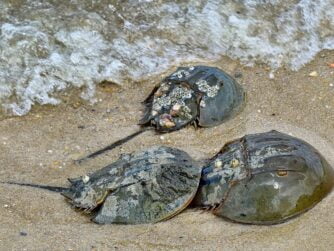Voice 1
Welcome to Spotlight. I’m Marina Santee.
Voice 2
And I’m Roger Basick. Spotlight uses a special English method of broadcasting. It is easier for people to understand, no matter where in the world they live.
Click here to follow along with this program on YouTube.
Voice 1
A woman sits in a boat floating on a small lake. She is fishing. She holds her fishing pole loosely, as if not expecting a bite. Suddenly, there is a pull on her line. She jumps up and seizes the instrument in her hand. A fish is on her line!
Voice 2
Excited, the woman pulls the fish closer and closer to the boat. But when she lifts the fish out the water, it is different than she expected. She was hoping to catch a lake trout, a large fish found in this lake. The fish she caught is just as large. But it is a shiny orange color. It is a goldfish. Below her in the water, there are thousands more just like it.
Voice 1
Goldfish are a kind of fish that are native to East Asia. People all over the world keep them as pets. Most people know them as small creatures swimming in glass tanks. But they grow much larger in the wild. They can destroy native fish populations. How did things get this way? Today’s Spotlight is on the invasion of the huge goldfish.
Voice 2
Goldfish have a long history as a decorative animal. Prized for their bright color in China, it was once illegal for anyone to own a goldfish except the ruler. In China, these fish symbolized good luck and wealth. Even after these laws went away, goldfish remained a symbol of social standing. People first brought goldfish to Europe in the 1600’s. There wealthy people put goldfish into private lakes. These fish made their lakes seem exotic. People could not find orange-colored fish in the wild there. They had to purchase them. So keeping goldfish was a way to show off social standing and wealth.
Voice 1
People brought goldfish to North America and Australia soon afterwards. We do not know the exact year. But records suggest that people brought them to the United States before the 1800s. These fish came to Australia soon after. Here, they noted a special social status as in Europe. But soon the goldfish would become the most common pet in all the world.
Voice 2
In 1874 the United States government received a shipment of goldfish from Japan. The United States Bureau of Fisheries began to raise the fish. And in the 1880’s, they started giving goldfish away to people living in Washington, D.C., and Baltimore. They designed these giveaways as a publicity stunt. It was an event designed to direct notice to their work with fisheries. But the giveaways changed the way people thought about goldfish, too. These exotic fish were no longer something special.
Voice 1
This feeling grew even after the Bureau of Fisheries stopped giving goldfish away. Other private fisheries continued to grow goldfish. The animals were easy to take care of. So people kept buying them as pets. In some places, people even gave them away as prizes. This led to the idea that people could throw these animals away. In time, this throwaway idea spread to other English-speaking countries like the United Kingdom and Australia.
Voice 2
Regrettably, what makes goldfish a good pet makes them a problem in the wild. Goldfish can survive in many different situations. They can eat almost anything. They live in colder water easily. They can even live in areas with little oxygen. This means that they can survive for a long time in a fish tank without care. It also means they can live successfully in almost any fresh water in the wild.
Voice 1
The goldfish’s ability to survive has made it a problem in countries like the United States, Canada, and Australia. In these nations, people who do not want their fish will release them into the wild. For them, it is an act of mercy not to kill the fish. But goldfish can be very bad for the environment. And, in the wrong conditions, a group of goldfish can kill off whole populations of other animals.
Voice 2
One of the biggest problems with goldfish is their size. Inside a tank of water, goldfish do not grow very large. But in the wild, goldfish easily grow thirty six centimeters long. This makes them too big for many predators to eat.
Voice 1
Goldfish also reproduce very quickly. One female goldfish can produce up to forty thousand eggs a year. With nothing to keep their numbers down, a few goldfish can take over. They will eat all of the food in the water. This leaves nothing for native animals. Goldfish also destroy native plant life. They change the environment around them to make it more difficult for other fish to live.
Voice 2
For some animals, goldfish makes life more difficult. But for others, the situation is deadly. Kevin Nechter is an invasive animals expert at the Nevada Department of Wildlife. He spoke to the website wideopenspaces.com about the problems with goldfish in his area.
Voice 3
“One of the biggest problems we have with them in Nevada is that we have many endemic species. These are animals that are only found in one place. When people bring goldfish to those places, it can sometimes cause these species to die out.”
Voice 1
Sadly, wild goldfish populations are now very widespread. Every state in the United States has wild goldfish in their waters. They are a problem in South Africa, Türkiye, and Australia. One river in Western Australia, the Vasse River, has the fastest reproducing population of goldfish in the world.
Voice 2
Organizations in these countries may never completely remove goldfish. But there are many things you can do to prevent incidents like the great goldfish invasion.
Voice 1
First, do not release your pets into the wild. Many common pets are not native. Give them to a new home if you are tired of them. Or donate them to a pet adoption agency.
Voice 2
Second, clean off your things if you are traveling. Small invasive species catch on clothing, shoes, and even the bottoms of boats. A swift clean can stop them from getting to places that they do not belong.
Voice 1
Finally, support your local environmental groups. These groups will manage invasive animals like goldfish. They will also inform you of threats to your local wildlife.
Voice 2
Have you ever had a goldfish as a pet? Have you seen one in the wild? You can leave a comment on our website. Or email us at radio@radioenglish.net. You can also comment on Facebook at facebook.com/spotlightradio.
Voice 1
The writer and producer of this program was Dan Christmann. The voices you heard were from the United Kingdom and the United States. All quotes were adapted for this program and voiced by Spotlight. You can listen to this program again, and read it, on the internet at www.radioenglish.net. This program is called, ‘The Invasion of the Goldfish’.
Voice 2
You can also get our programs delivered directly to your Android or Apple device through our free official Spotlight English app. We hope you can join us again for the next Spotlight program. Goodbye.
Question:
Have you ever had a goldfish as a pet? Have you seen one in the wild?








When I was a child, my father bought some goldfishes for me and put them in a glass tank. However, they died soon after that. I thought goldfish are one of the most beautiful decorative animals in the water. I’ve even never thought that they can live anywhere except in the tanks until reading this article. You see.. how pretty and softy they are in glass tanks!! How can they become so huge and “ugly” as released into the wild 🙁
You may be misundertood. They said about another kind of goldfish named “Koi fish” in Japanese. These fishes are originally from Japan. It is true that in the wild, they can grow so quickly and become so big compared to other local fishes. I can see the invasion of Koi fish recently in Vietnam but it is still not too scary. In many tourist places like at Ninh Binh Trang An complex, Uncle Ho’s pond or even many restaurants or hotels, or homes they started to raise them as a beautiful pets. Luckily, in Vietnam their fishes can become a food too. Therefore, it is not an alert if these fishes are released in the wild.
I foreget if i had seen one or another kind of fish but thank you anway❤.
Very nice
Thanks, that is exciting Topic and useful.
I want to study English language
A few days ago I listened to an old man on the radio talking about his cat. He spoke with difficulty due to emotion and was crying. The cat had been all the joy and all the company of him to his solitude, but now in recent times the cat was old and sick, until one day he went away to die far from the sight of his master, as required by the dignity of him. The old man declared himself very saddened by not being able to bring a flower to his cat, a friend of many years, and he felt more alone. I apologize if I strayed from the requested topic. Regarding the subject of the program, I can say that if I see a fish inside a small glass container, it seems to me that it is a prison.
No ,I didn’t see a goldfish
No I have not.
No.
I did not see goldfish
Thank you so much .this was an interesting subject
No but I would like to